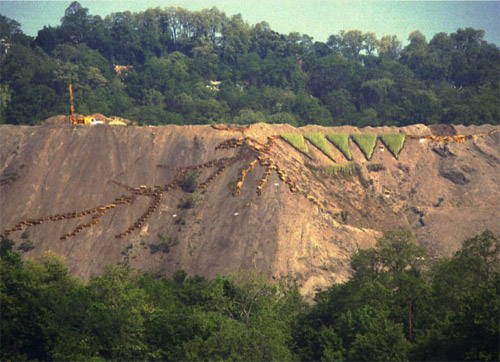
A slag slope revegetation demonstration project. Source: CMU Nine Mile Run Greenway Project.
When redeveloping the slag heaps that scarred Nine Mile Run, the Pittsburgh URA focused first on economic development; environmental concerns surfaced later. The concept of Nine Mile Run as a natural system worth preserving is relatively new to the project, and still not really the forefront issue with respect to “greening the city.” The city has had other – more pressing? – environmental health issues citywide to deal with first, like clean air and clean water.
The original redevelopment plan for Nine Mile Run recommended culverting and burying the stream, but this was met with strong opposition from the public.
The result of community outcry to the original plan was the Nine Mile Run Greenway Project: “The unifying theory of the Nine Mile Run Greenway Project is reclamation as an integrated ecosystem restoration that embraces the complex goal of ‘nature’ in the context of contemporary urban culture.” (from website: http://slaggarden.cfa.cmu.edu).
The continuing push towards environmental stewardship and a return to the “natural” state of the stream and its surroundings has been accomplished by citizens, nonprofits and the private sector, bringing in the government where necessary. For example, the Army Corps of Engineers is currently responsible for the stream ecosystem restoration.
The Nine Mile Run Watershed Association grew out of Carnegie Mellon University’s studio efforts, the Nine Mile Run Greenway Project, and was founded in 2001. The Association is now largely responsible carrying on the mission of overseeing the restoration projects and engaging citizens with this urban natural resource through volunteer and educational programming.